
Chapter 3
100[%] |
| Aperture Stop 4.0 |
| |
|
|
|
| |
80 |
|
|
|
|
60 |
|
|
|
|
40 |
|
|
|
|
20 |
|
|
|
|
0 |
|
|
|
|
0 | 5 | 10 | 15 | 20 |
|
|
|
| Y'[mm] |
100[%] |
| Aperture Stop 5.6 |
| |
|
|
|
| |
80 |
|
|
|
|
60 |
|
|
|
|
40 |
|
|
|
|
20 |
|
|
|
|
0 |
|
|
|
|
0 | 5 | 10 | 15 | 20 |
|
|
|
| Y'[mm] |
100[%] |
| Aperture Stop 8.0 |
| |
|
|
|
| |
80 |
|
|
|
|
60 |
|
|
|
|
40 |
|
|
|
|
20 |
|
|
|
|
0 |
|
|
|
|
0 | 5 | 10 | 15 | 20 |
|
|
|
| Y'[mm] |
Leica | 8 |
|
|
Even so, the optical quality of the 280 mm lens is higher. Here we can detect the limit of the MTF graphs when we restrict our- selves to 40 Lp/mm as the highest frequency. There are sound arguments for this limit, but when dealing with very high perfor- mance lenses, the information may not be as we want it to be. The 280 mm f/4
The 280 mm f/4
The big question is: how do we obtain this performance on the negative?
__ High-resolution photography
Let us make it clear from the start. Under practical circumstan- ces, we can achieve a visible and usable resolution of more than 150 Lp/mm on microfilm (Agfa Copex and Kodak Techni- cal Pan).
At first sight this may appear to be a bit disappointing. But 150 Lp/mm are 300 separate lines in one millimeter and that means that every single line has a width of 0.003 mm – an exceedingly small number!
Between two black lines there is a single white separation of a mere 0.003 mm in width. The smallest halo caused by the lens or by the grain in the emulsion, will reduce that separation line to a dark gray one, making the difference between black and white disappear. The same holds for the slightest movement of camera or subject.
Occasionally you will read about film emulsions that are capa- ble of resolving 700 Lp/mm or more in normal photographic situations
The 280 mm f/4
